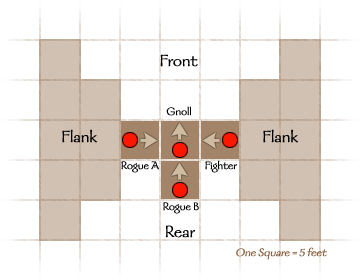Hi !
I'm a rogue in a D&D game, and last night we came upon a special case.
I was in front of an enemy, who had already acted in that round.
So I wasn't able to do a sneak attack on him since he wasn't
flatfooted.
Next thing you know, the other rogue in the group (who was invisible)
does a double move and ends up behind our enemy. The enemy had effecively
one rogue in front of him, and one behind him.
Right after that, it was my turn to play, and I decided to attack the enemy.
But the enemy wasn't aware of the presence of the other rogue behind
him. SO: Should I have been allowed a flanking bonus of +2 (and a sneak
attack) or not ?
Does the rules (or clarifications of the rules) cover that anywhere ?
Thanks for your replies !
I'm a rogue in a D&D game, and last night we came upon a special case.
I was in front of an enemy, who had already acted in that round.
So I wasn't able to do a sneak attack on him since he wasn't
flatfooted.
Next thing you know, the other rogue in the group (who was invisible)
does a double move and ends up behind our enemy. The enemy had effecively
one rogue in front of him, and one behind him.
Right after that, it was my turn to play, and I decided to attack the enemy.
But the enemy wasn't aware of the presence of the other rogue behind
him. SO: Should I have been allowed a flanking bonus of +2 (and a sneak
attack) or not ?
Does the rules (or clarifications of the rules) cover that anywhere ?
Thanks for your replies !

